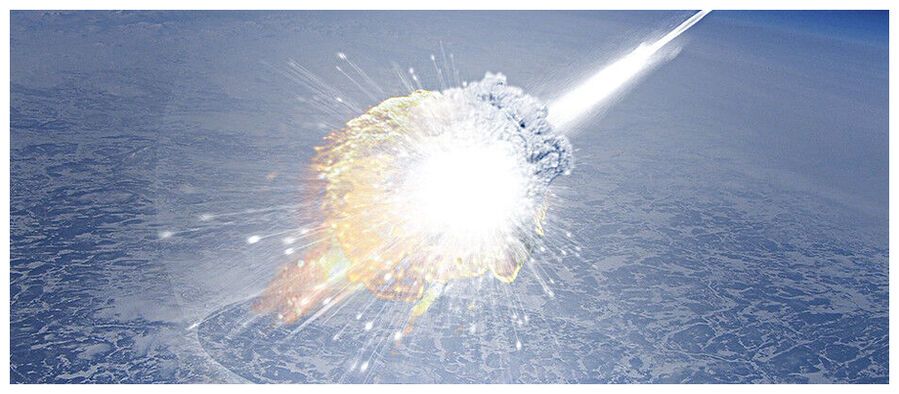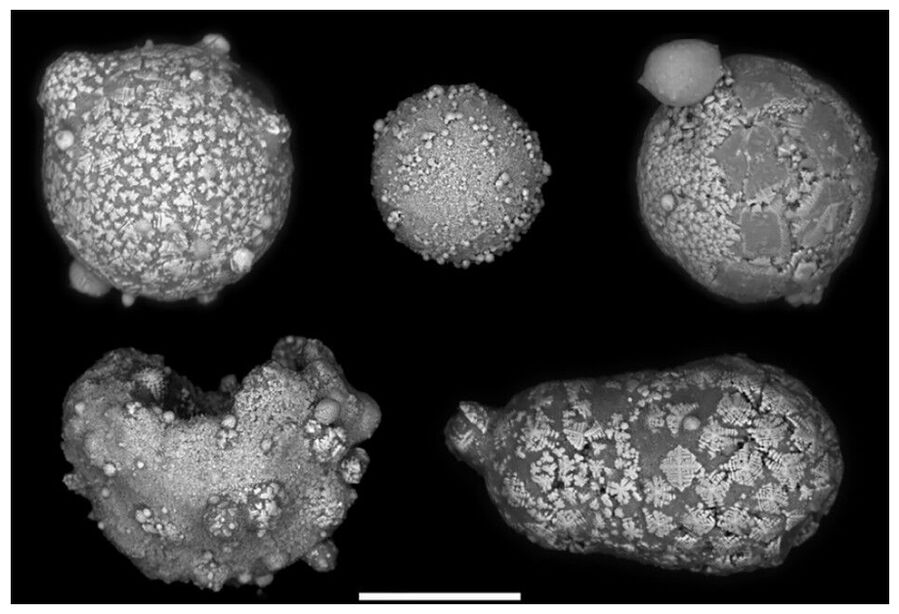
© astronomynow.com
A paper published in March of 2021 in the journal
Science Advances reports on the discovery of evidence for a large airburst type impact within the SØr Rondane Mountains, Queen Maud Land, East Antarctica. The report bears the names of a 15-member international team that did the research. The lead author was M. Van Ginneken with the Belgian Geological Survey. In the first sentence of the abstract to the article the authors support something I have been saying for literally decades:
"Large airbursts, the most frequent hazardous impact events, are estimated to occur orders of magnitude more frequently than crater-forming impacts."This fact is confirmed simply because
airbursts don't leave impact craters. In this case the fingerprints of the event took the form of condensation spherules resulting from "a touchdown event, in which a projectile vapor jet interacts with the Antarctic ice sheet." The authors go on to explain that "Finding evidence of these low-altitude meteoritic events thus remains critical to understanding the impact history of Earth and estimating hazardous effects of asteroid impacts." They further report that "In recent years, meteoritic ablation debris resulting from airburst events have been found in three different locations of Antarctica. The material . . . all appears to have been produced during a Tunguska-like airburst event 480 thousand years (ka) ago."
With respect to their research, they say: "Here, we present the discovery of extraterrestrial particles formed during a significantly larger event recovered on . . . Queen Maud Land, East Antarctica. The characteristic features of the recovered particles attest to an unusual type of touchdown event, intermediate between an airburst and a crater-forming impact, during which the high-velocity vapor jet produced by the total disruption of an asteroid reached the Antarctic ice sheet." This event was estimated by the team to have occurred about 430 thousand years ago.
The authors provide some critical perspective on the effects of these type of impacts:
"The impact hazards resulting form the atmospheric entry of an asteroid that are currently being addressed by impact mitigation programs depend mainly on whether the impactor reaches the ground or is entirely disrupted in the atmosphere (i.e., airburst). For small-to medium-sized impactors (50- to 150-m diameter) producing airbursts, the main hazard is limited to blast effects resulting in strong overpressures over areas of up to 100,000 km2 wide. [38,600 sq miles] Thermal radiation may also result in fires over an area of 10 to 1000 km2 wide. . . . in addition to shockwaves and thermal radiation covering the aforementioned areas, these events are potentially destructive over a large area, corresponding to the area of interaction between the hot jet and the ground. The authors point out that such an event over Antarctica would inject ice crystals and impact dust into the upper atmosphere but would not directly affect human activity.
However, they explain that "if a touchdown impact event takes place above a densely populated area, this would result in millions of casualties and severe damages over distances of up to hundreds of kilometers."Now comes a new report in
Earth and Planetary Science Letters on the discovery of evidence for yet another airburst event over Antarctica. The 11-member team responsible for the report is comprised of geologists, astrophysicists, and archaeologists from the U.S., the United Kingdom, Belgium, Russia, Japan, France and Italy.
The authors set the stage:
"Airbursts are the sharp release of impact energy when asteroids less than 200 m in size are disrupted in the lower atmosphere. Shockwaves and thermal radiation produced by airbursts result in massive damage at ground level, as evidenced by the 2013 Chelyabinsk small-scale airburst that resulted from the atmospheric entry of a stony asteroid approximately 20 meters in diameter. Surveys of the population of Near-Earth Asteroids smaller than 140 m, along with numerical models simulating effects at ground level, suggest that
airbursts are currently the biggest cosmic threat to populations and infrastructure by combining their destructive potential and calculated frequency. However, contrary to cratering events that can be identified using a set of well-defined geomorphological, mineralogical and geochemical criteria,
evidence for past airbursts are poorly constrained. This is partly due to the lack of easily recognizable impact structures created by such events, but also a limited knowledge of physical and geochemical processes leading to the formation of potential residues."The authors of the new paper go on to reference the work published in 2021 that I discussed above.
"The recent discovery of airburst spherules from Antarctica demonstrates that past airburst events can be identified on the grounds of petrological and geochemical evidences. So far, two spherule populations have been reported to have originated from large airbursts approximately 430 and 480 thousand years ago over Antarctica. While both events were airbursts, their scale and regional effects were likely different. The older one was likely similar to the Tunguska event from 1908, where
damage at ground level was mostly due to an intense shockwave and thermal radiations. The younger event was described as a touchdown event, or type II airburst, when the jet of vaporized impactor material does not lose momentum and reaches ground level at hypervelocity, resulting in chemical exchange between projectile superheated gas and vaporized ground material, in this case Antarctica ice. These two airburst spherule populations suggest that airburst events may have varied extensively in scale in the past, from normal airbursts not reaching ground level."
The new paper points out that the particles from the 430 year ago event produced petrological and geochemical signatures almost identical to that of dark, spheroidal particles from a dust horizon found by scientists when sampling volcanic ash at a well-known Antarctic meteorite collection site in the Allan Hills ice field back in 1994. This sample was designated as BIT-58 and the finding was reported in the journal
Geology in 1998. Preliminary cosmogenic isotope dating suggested an age for the deposition of the material of 2.3 to 2.7 million years. The chemistry of the sample suggested that it originated as a chondritic type meteorite.
Regarding this report the authors explain that "Here we explore BIT-58 particles further. . . We demonstrate that these particles represent a third distinct airburst spherule population in Antarctica, which has implications for the identification of such hazardous events in the geological record."
The character of these spherules supports the conclusion that they are consistent with an event in which "airburst simulations have shown that in the case of stony asteroids approximately 150 m in diameter, the jet of superheated gas produced by the vaporization of the asteroid will not lose momentum before reaching ground level at hypervelocity."
For the sake of comparison,
an object 150 meters in diameter is roughly 27 times larger in terms of volume than the Tunguska impactor.
© Randall Carlson Newsletter - April 2024
In conclusion the authors explain that:
"Mineralogical and geochemical characteristics of the particles constituting the BIT-58 extraterrestrial dust horizon reveal that these were formed during a large low-latitude airburst between 2.3 and 2.7 million years ago. The oxygen isotopic values of the particles exhibit extremely negative δ18O values, suggesting contamination by Antarctic ice during their formation in the airburst plume. This points to a touchdown impact, when the jet of vaporized impactor maintain momentum and reaches the ground at hypervelocity. This is the second, and oldest, touchdown impact identified in Antarctica so far. . . This work has important implications for the identification of airburst in the paleorecord."
This work is important in that it
underscores a very real hazard to the stability of human civilization. The ongoing accumulation of evidence supports the conclusion that the Earth exists in a cosmic environment in which multiple classes of interactions can, and do, occur with profound effects. The geological record bears witness to the disturbing frequency with which catastrophic events have afflicted this planet. I would argue that
our obsession with war and conflict for control of planetary resources is actually a major distraction from the unified response the human species must undertake if our civilization is to survive and endure. The irony is that the agencies responsible for the reoccurring cosmic assaults upon the Earth that have driven mass extinctions and global upheavals also provide human civilization with a tremendous opportunity in that all the resources over which nations are now contending, and which are pushing us closer to World War, can be found in infinite abundance in the vast cosmic ecosystem of which we are a part. All that is needed is the vision and the will to rise to the challenge. However,
in America at least, the current crop of "leaders" I would deem to be utterly incapable of such a heroic task, obsessed as they are with their obsolete zero-sum mentality. What this Earth desperately needs is a massive grassroots awakening to both the dangers and the possibilities before us and a realistic assessment of our predicament.We are literally, as I have said many times, sitting ducks in a cosmic shooting gallery.References:
See: Ginneken, Matthias van & 10 others (2024)
The identification of airbursts in the past: Insights from the BIT-58 layer: Earth and Planetary Science Letters, vol. 627, Feb. 1, p. 118562.
Ginneken, M. Van & 14 others (2021) A large meteoritic event over Antarctica ca. 430 ka ago inferred from chondritic spherules from the SØr Rondane Mountains:
Science Advances, Vol. 7, #14, March 31, eabc1008.
Harvey, R.P. & 5 others (1998) Meteoritic event recorded in Antarctic ice:
Geology, Vol. 26, #7, July 1, pp. 607- 610.
The destruction of the then 3rd planet, before the birth of Venus and Mercury, gave rise to many comets. In the early days after Cain had killed Abel, these created many airbursts. Sands likely also landed in large belts across the Earth, making those deserts we see on TV.
Of course, a Nova is also a source of these, as the photosphere is 'blown off'.